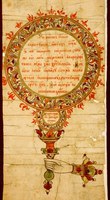Manuscripts in the Collection of the Slavonic Library
The collections of the Slavonic Library contain several hundred historical manuscript documents. The earliest of them is a folio coming from an unknown manuscript of the fourfold Gospel, Tetraevangelium), which contains synoptic tables 6–9 for the Gospels and was written in Byzantine Greek before the turn of the 12th century.
The earliest documents directly related to the profile of the library are two letters coming from what is now Croatia: a letter by the duke of Ston to the government from 9 October 1438 and a letter by the governor of Mljet (Meleda) to the government from 26 February 1441. They both form part of Milan Rešetar’s library of Ragusan literature, which contains among others 250 manuscripts on the theme of Dubrovnik (mostly handwritten copies of South Slavic works, Italian and other authors from the middle of the 16th century until the end of the 19th century).
The highest number of materials in the Slavonic Library come from Russia. The most important Cyrillic manuscripts can be found in the collection of 68 manuscripts from the 17th–19th centuries, which was gathered by Prof. Aleksandr Dmitrievich Grigorʼev in North Russia, and the collection of archival documents from the 17th–18th century from the library of the historian Vasilii Osipovich Kliuchevskii. One can mention e.g. Sbornik chtenii i skazanii o sviatykh Iarengskikh chudotvortsakh Ioanne i Loggine by Sergii Shelonin (17th cent.), whose binding contained handwritten Cyrillic fragments coming from as early as the 13th century.
The earliest Cyrillic manuscripts include e.g. Aprakos Gospels (16th cent.), Triodʼ tsvetnaia / Pentekostarion (16th cent.), Triodʼ postnaia (16th cent.) and The Four Gospels from 1594. A very rare manuscript is Zhurnal o pokhode v Azov boiatina Alekseia Semenovicha Sheina v 1697 g. [A Diary of Aleskei Semenovich Shein’s Azov Campaign in 1697].
A remarkable manuscript in the collections of the Slavonic Library is the almost ten-meter-long, richly decorated hand-coloured scroll Svitok chestnyi i presviateishii... from the last quarter of the 17th century. Both textually and visually, it clarifies the basic doctrinal postulates of Old Believers and contains their polemic with the reform of Patriarch Nikon.
For more information on Old Russian manuscripts, click here.
Rare Belorussian items include a handwritten copy of the Apostol by Francysk Skaryna from the turn of the 17th century, probably from the area of Volhynia.
A list of Cyrillic Church Slavonic manuscripts in the Slavonic Library was published in the catalogue: Z církevněslovanských rukopisů Národní knihovny v Praze a Slovanské knihovny [From the Church Slavonic Manuscripts in the National Library in Prague and the Slavonic Library] / edited by Josef Vašica. Praha, Národní knihovna v Praze 1995.
Among manuscripts of Polish provenance, it is worth mentioning mainly the parchment folios containing the privileges of Queen Bona from 1554 or Regestr spissania dwora … Trokielskiego from 1581, in which one can find texts both in Old Polish and in Old Belorussian.
The Slavonic Library further owns numerous modern handwritten documents, including e.g. fragments of the correspondence of famous writers (P. Ia. Chaadaev, L. N. Tolstoi, F. M. Dostojevskii, A. M. Remizov and others) and many other documents mainly from the 19th century and the beginning of the 20th century concerning Slavic culture. The library collection further comprises several large literary estates, among which one can highlight the correspondence of the Ukrainan poet Lesia Ukrainka or the Sorbian historian and cultural figure Michał Hórnik. Russian and Ukrainian émigrés are relatively richly represented (parts of the personal legacies of V. N. Tukalevskii, P. N. Savitskii, A. V. Florovskii, P. Fedenko, V. Modzalevskyi, I. Leontovych, A. L. Bem, E. F. Shmurlo, and documents of various Russian and Ukrainian émigré organisations). Inventory lists of the catalogued collections are gradually made available on the internet.









